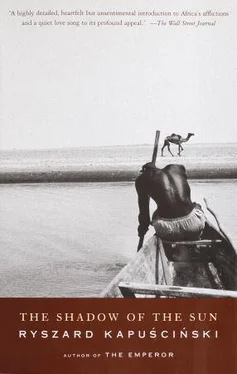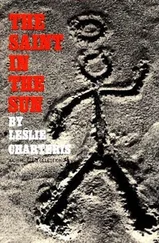The Tuareg are perishing, their way of life is ending. In the past, a portion of them lived by robbing caravans, which these days are both infrequent and well armed. Most important, severe and constant droughts are pushing them out of the Sahara. They must go where there is water, but all those regions are already occupied. The Tuareg live in Mali, Algeria, Libya, Niger, Chad, and Nigeria, as well as a few other Saharan countries. But they do not consider themselves to be the citizens of any state, do not want to subordinate themselves to anyone else’s government, to any authority.
There are around a half million of them left, perhaps one million. No one has ever counted this mobile, mysterious, reclusive community. They live apart, secreted not only physically but also mentally in their impenetrable Sahara. The outside world holds no interest for them. It does not occur to them to explore the oceans, as the Vikings did, or to tour Europe or America. When a European traveler they had captured told them that he was headed for the Niger, they refused to believe him: “Why the Niger? Are there no rivers in this country?” Despite the fact that the French occupied the Sahara for more than half a century, the Tuareg had no desire to learn French, were interested neither in Descartes nor in Rousseau, in Balzac or Proust.
My neighbor on the bus, a merchant from Mopti called Diawara, does not like the Tuareg. He is afraid of them and pleased that in Mopti the troops have dealt with them successfully. “Dealt with them” means that some of the Tuareg were killed, and others chased so deep into the Sahara that they would soon die from lack of water. When we arrive (the bus trip lasts a whole day), Diawara will ask his cousin, one Mohamed Kone, to show me the traces of the Tuareg’s presence. Mopti is a great port on the Niger, and the Niger is one of the three largest rivers in Africa, after the Nile and the Congo. For two thousand years Europeans argued about which way the Niger flows, and into which lake, river, or sea it empties. The reason for these controversies was the strange course of the river, which originates not far from the western shores of Africa, in Guinea, flows deep into the continent, toward the heart of the Sahara, until suddenly, as if encountering in the great desert some insurmountable barrier, it turns in the opposite direction, south, and on the territory of present-day Nigeria, near Cameroon, empties into the Gulf of Guinea.
As seen from the high bank upon which Mopti is situated the Niger is a wide, dark brown, slowly flowing river. It is an extraordinary sight: all around, blazing hot desert, and then suddenly, in a stony channel, this immense expanse of water. Moreover, the Niger, in contrast to other Saharan rivers, never dries up, and this image of an eternally flowing stream amid limitless sands inspires such awe and devotion in people, that they regard the waters of the river as miraculous and holy.
Mohamed Kone turned out to be a young boy with no clearly defined occupation, a typical bayaye, living off whatever he could. He had a friend called Thiema Djenepo who owned a boat (he later gave me his business card — Thiema Djenepo, Piroguer, BP 76, Mopti, Mali) and took us, rowing with difficulty against the current, to a little island on which stood the scattered remnants of recently demolished mud houses: vestiges of a Tuareg attack on a village of Mali fishermen. “Regardez, mon frère,” Mohamed said to me in a familiar way. “Ce sont les activités criminelles des Tuaregs!” I asked him where would be the best place to meet them, in response to which Mohamed just laughed and looked at me with pity: to him, this was akin to my inquiring about how best to commit suicide.
The most difficult thing was getting from Mopti to Timbuktu. The road through the desert was closed by the army, for battles were still being fought somewhere in the interior. One could get closer to them, but this would take weeks. The only real option was a small Air Mali plane, which flew sporadically, sometimes once a week, sometimes once a month. In this part of the world, time has no measure, no reference points, shape, or tempo. It spreads, melts, and it is difficult to seize it, to give it form. I secured a seat by bribing the manager of the Mopti airport. One flies over the Sahara — moonlike, surreal, full of mysterious lines and signs. The desert is clearly telling us something, communicating something, but how can we understand it? What do these two straight lines mean, which appear suddenly in the sand and just as quickly vanish? And those circles, an entire chain of them, symmetrically positioned? And these zigzags, broken triangles, and rhomboids, followed by arched lines and twisting ones? Are they the traces of lost caravans? Of human settlements? Of campgrounds? But how could one possibly live on this sizzling pan? Along what road would one have traveled to arrive here? And which way would one flee?
We landed in Timbuktu straight into the muzzles of the antiaircraft guns guarding the runway. The town consists of clay houses built on sand. The clay and the sand are the same color, so the town looks like an organic part of the desert — a fragment of the Sahara shaped into rectangular blocks and elevated. The heat curdles the blood, paralyzes the body, stuns. I did not encounter a living soul in the narrow streets and back alleys. But I found a house with a plaque informing that here, from September 1853 until May 1854, lived Heinrich Barth. Barth was one of the greatest travelers in the world. For five years he journeyed alone through the Sahara, keeping a diary in which he described the desert. Several times, sick and pursued by bandits, he bade his life farewell. Dying of thirst, he would cut his veins and drink his own blood to survive. Eventually he returned to Europe, where no one appreciated the unique feat he had accomplished. Bitter, worn out by the hardships of his voyage, he died in 1865 at the age of forty-four, not understanding that the human imagination is incapable of traveling to the frontier he had crossed in the Sahara.
Behold, the Lord Rideth upon a Swift Cloud
When I entered, the interior was already filled by a throng of the faithful. All were kneeling, motionless on simple, backless benches. Their heads were bowed and their eyes were closed. There was total silence.
“They are confessing their sins and humbling themselves before God, so as to lessen His anger,” whispered the parishioner who had earlier arranged permission for me to enter and who now accompanied me.
We were in the city of Port Harcourt, situated in the hot and humid Niger delta. The temple belonged to a congregation called the Church of the Faith of the Apostles, one of the several hundred Christian sects active in southern Nigeria. The Sunday mass was about to begin.
It is not easy for an outsider to gain admittance to such a rite. I had tried my luck to no avail in other towns and with other congregations (I am using terms interchangeably here — sect, congregation, gathering, church — because they are used this way in Africa). The sects engage in a politics characterized by a certain contradiction: on the one hand, each tries to have as many adherents as possible, but on the other makes acceptance a long and painstaking procedure, with extremely careful screening and selection. This is the consequence not only of doctrinal demands; there are also important economic reasons. The majority of these sects have their headquarters in the United States, in the Antilles and the Caribbean, or in Great Britain. It is from there that donations of money as well as medical and educational assistance flow to the African affiliates.That is why, in indigent Africa, there is no end to those who want to join a sect. But the sects are intent on their followers having suitable social and material standing. The poor and the down-and-out are not admitted. There are many thousands of these congregations in Africa, and millions of members.
Читать дальше












